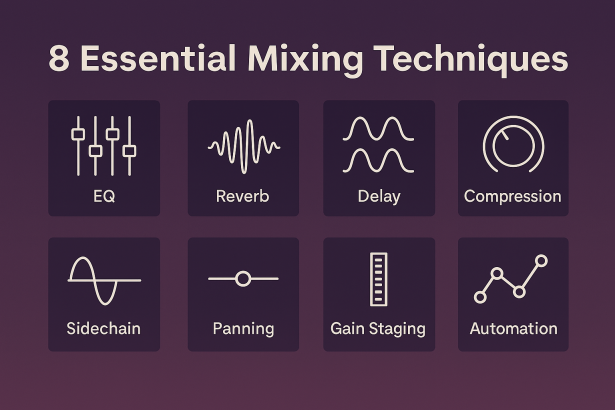8 Essential Mixing Techniques Every Beginner Should Learn in Music Production
Introduction
Mixing is where raw recordings transform into polished, professional tracks. For beginners in music production (MAO), the number of tools—EQ, reverb, compression, delay—can feel overwhelming. But mastering just a few core concepts can drastically improve your sound. In this guide, we break down 8 essential mixing techniques, with clear explanations and real-world applications.
1. EQ: Sculpting Your Frequencies
EQ (equalization) allows you to boost or cut specific frequency ranges. Use subtractive EQ to clean up muddy frequencies and additive EQ to enhance clarity.
🛠 Try:
👉 TDR Nova (free)
👉 FabFilter Pro-Q 3
2. Reverb: Adding Depth and Space
Reverb simulates space—whether it’s a small room or a vast cathedral. It gives life to vocals and instruments, creating atmosphere and depth.
🎯 Tip: Use pre-delay to separate the original signal from the reverb and prevent muddiness.
🛠 Try:
👉 Valhalla Supermassive (free)
👉 Valhalla VintageVerb
3. Delay: Creating Echo and Width
Delay creates echoes that can add movement or texture to your track. Whether it’s slapback, ping pong, or tape delay, each style offers a unique character.
🛠 Try:
👉 TAL-Dub II (free)
👉 EchoBoy by Soundtoys
4. Compression: Controlling Dynamics
Compression evens out volume differences, controls peaks, and adds punch. It’s crucial on vocals, drums, and bass.
🎯 Learn your basics: threshold, ratio, attack, release, and make-up gain.
🛠 Try:
👉 RoughRider 3 (free)
👉 FabFilter Pro-C 2
5. Sidechain Compression: Let the Kick Breathe
Sidechaining reduces the volume of one sound when another plays—commonly used to duck the bass when the kick hits. It helps clarify your low-end and adds groove.
🛠 Try:
👉 Cableguys ShaperBox
👉 Kickstart 2 by Nicky Romero
6. Panning and Stereo Imaging: Create Space
Panning places sounds across the stereo field (left-right), while stereo imaging adds width and separation. Proper panning makes the mix feel open and immersive.
🎯 Keep low-end (kick, bass) in mono; spread guitars, synths, and FX for width.
🛠 Try:
👉 Ozone Imager (free)
7. Gain Staging: Control Before You Mix
Gain staging ensures every plugin in your chain receives the right signal level. If it’s too loud or too soft, your plugins won’t react properly—leading to distortion or flatness.
🎯 Keep levels around -18 dBFS before compression and EQ.
🛠 Try:
👉 VUMT Meter
8. Automation: Bring Your Mix to Life
Automation controls how parameters change over time—volume swells, filter sweeps, reverb throws. It adds emotion, energy, and dynamics to otherwise static tracks.
🎯 Automate:
- Volume fades
- Delay throws
- EQ frequency shifts
- Reverb wet/dry levels
🛠 Your DAW’s automation tools (FL Studio, Ableton Live, Logic Pro) are already powerful enough!
🎯 Conclusion
These 8 mixing techniques are the foundation of every great mix. Start with the basics—EQ, reverb, compression—then explore creative tools like automation and sidechain to inject personality. With time, your ear will guide your decisions. Until then, experiment, compare, and trust the process.
📌 Want to go deeper? Explore each topic individually or download free plugins and practice them on your next track.
![]()














